Lexicon of the Hamas Organization
Shia Islam
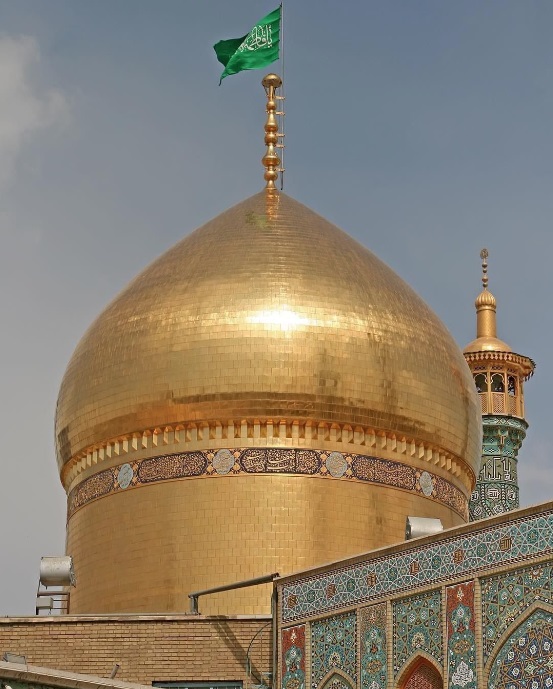
Fatima Masumeh Shrine in Iran. Credit: salam Ya Hussain’s FB page.
Shia Islam, one of the two major branches of Islam, holds significant influence in the religious and political landscape of the Middle East. Understanding Shia Islam, its history, and its role in contemporary geopolitics is crucial for comprehending the complexities of the region.
Historical Background of Shia Islam
The origins of Shia Islam trace back to the early Islamic period, following the death of the Prophet Muhammad in 632 AD. The primary point of contention that led to the Sunni-Shia split was the question of rightful leadership succession. Shia Muslims believed that leadership should remain within the Prophet’s family, supporting Ali, Muhammad’s cousin and son-in-law, and his descendants.
Over centuries, Shia Islam evolved distinct theological beliefs and practices. However, it remained the minority sect in comparison to Sunni Islam, leading to various historical conflicts and power struggles within the Islamic world.
Shia Islam vs. Other Islamic Sects
Fatima Masumeh Shrine, Iran. Credit: Shis Muslim’s FB page.
While Shia and Sunni Islam are the two main branches, other sects like Sufism and the Khawarij also exist within the Islamic mosaic. Sunni Islam, the larger of the two main branches, differs from Shia Islam primarily in matters of religious leadership and jurisprudence. Sufism, often regarded as a mystical dimension of Islam, focuses on spiritual practices and has followers in both Sunni and Shia Islam. The Khawarij, a smaller and more radical sect, emerged in the early Islamic period, known for their strict and literal interpretation of the Quran.
Iran’s Role in Shia Islam
Iran is the most prominent Shia-majority country and plays a central role in the political and religious dynamics of Shia Islam. The Safavid dynasty’s conversion of Iran from Sunni to Shia Islam in the 16th century marked a significant turning point, setting the stage for Iran’s future as a Shia stronghold.
In the contemporary era, the 1979 Iranian Revolution, which established an Islamic Republic, significantly impacted the region’s geopolitical landscape. Iran’s government, led by a Shia clerical elite, actively supports Shia groups and movements across the Middle East, asserting its influence in the predominantly Sunni region.
Shia Islam in the Israel-Arab Conflict
The involvement of Shia Islam in the Israel-Arab conflict is predominantly seen through the activities of Iran and Hezbollah, a Shia Islamist militant group based in Lebanon. Hezbollah, financially and militarily supported by Iran, has been a key player in conflicts against Israel. Iran’s support for Hezbollah is part of its broader strategy to extend its influence in the region and challenge Sunni-dominated countries and Israel.
Hamas’s Relationship with Shia Islam
While Hamas is primarily a Sunni Islamist organization, its relationship with Shia-dominated Iran and other Shia groups is notable. Hamas has received support from Iran, despite the sectarian differences. This alliance is driven more by shared political objectives against Israel than religious alignment. The Hamas-Iran relationship underscores the complexity of Middle Eastern alliances, where geopolitical interests often transcend sectarian divides.
Conclusion
Shia Islam’s role in the Middle East is a tapestry of historical depth, religious belief, and contemporary political strategy. Understanding the nuances of Shia Islam, Iran’s leadership role, and the dynamics of Shia involvement in regional conflicts offers valuable insights into the complex web of Middle Eastern geopolitics.
Lexicon of the Hamas Organization
The Kfar Aza Massacre
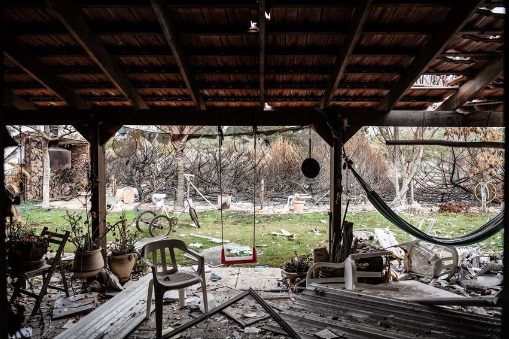
Kfar Aza after October 7th attack. Credit: �?חנה הייבלום’ FB page.
The Kfar Aza massacre, which took place on October 7, 2023, stands as a brutal chapter in the history of the Israel-Arab conflict. This article synthesizes information from multiple sources to provide a comprehensive understanding of the event.
Background and History of Kfar Aza
Kfar Aza, a kibbutz situated about 3 kilometers from the Gaza Strip border, was a peaceful community of over 700 residents before the attack. The kibbutz is typical of many such communities in southern Israel, known for their modest architecture and a sense of close-knit communal living.
The Attack on October 7, 2023

Entire Kutz family murdered in Kfar Aza. Credit: �?ישר�?ל ביתנו’ FB page.
On this fateful day, approximately 70 Hamas militants infiltrated Kfar Aza, launching a surprise attack that left the kibbutz in ruins. The attack was part of a broader offensive against over 20 towns and villages in southern Israel. The militants targeted the west side of the community first, an area where families with young children resided. They brutally massacred residents, torched cars and homes, and abducted several hostages. Reports indicate that the militants took women, children, and senior citizens among the hostages back to Gaza.
Casualties and Aftermath
The attack led to the deaths of 52 people at Kfar Aza, with more than 20 missing. The massacre was characterized by extreme brutality, including claims of beheadings, dismemberment, and burning of victims alive.
Survivors’ Stories
Survivors’ accounts paint a harrowing picture of the massacre. One survivor, Avidor Schwartzman, described how he and his family hid in a safe room for over 20 hours, witnessing the devastation of their community upon their rescue. Another resident, Gili Okev, recounted spending seven hours trapped in a safe room while the terrorists were just outside. Hanan Dann, a resident who survived with his family in a safe room, shared the tragic story of the Almog-Goldstein family, part of which was killed and part abducted to Gaza.
Rebuilding and Reflection
Despite the devastation, some residents expressed their determination to rebuild and not let the terrorists dictate their future. Gili Okev stated, “We will come back here and we’ll rebuild this place and it will flourish and grow”. This sentiment underscores the resilience and spirit of the community in the face of tragedy.
Conclusion
The Kfar Aza massacre was a tragic event that has deeply impacted the residents and the broader Israeli society. The stories of the survivors and the lost, along with the community’s resolve to rebuild, highlight both the brutalities of Hamas and the unyielding human spirit of the people of Kfar Aza.
Lexicon of the Hamas Organization
Nir Oz Massacre
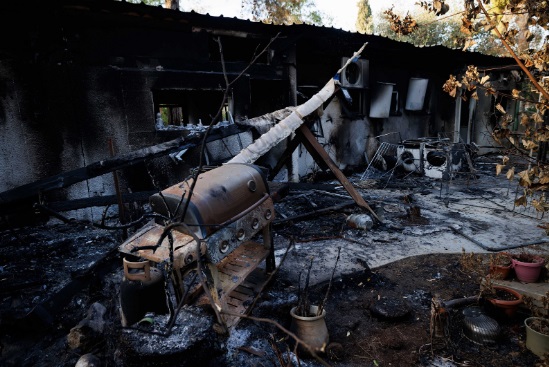
a burnt house in Nir Oz in October 7th. Credit: Kibbutz Nir Oz’s FB page.
Background History – Location, Community
The Nir Oz massacre occurred at the Nir Oz kibbutz in southern Israel. This community, known for its resilience and unity, became the epicenter of a horrific event that would mark one of the darkest days in the region’s history. The kibbutz, like many others in Israel, was a symbol of collective living and a testament to the enduring spirit of its residents.
The Assault on October 7th
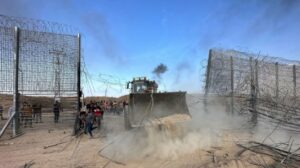
Palestinian tractor breaking through the border. Credit: Oz Koren’s FB page.
On October 7, 2023, Palestinian militants from the Gaza Strip executed a surprise attack on Israel, with Nir Oz Kibbutz being one of their primary targets. The attack was not just an isolated act of violence but part of a larger, coordinated assault across southern Israel, marking a significant escalation in the ongoing Israel-Arab conflict. The militants invaded the kibbutz, leading to widespread destruction and loss of life.
Death Toll and Casualties
The Nir Oz massacre resulted in the tragic loss of a significant portion of the kibbutz’s population. Out of approximately 400 residents, 180 were killed or abducted as hostages, according to The New York Times. The Jerusalem Post estimated about 80 abductions in Nir Oz alone. A veteran war correspondent reported that around a quarter of Nir Oz’s population was assassinated, kidnapped, or severely injured.
Evidence from Survivors
In the aftermath of the massacre, the survivors’ accounts painted a harrowing picture of the events. The kibbutz’s kindergarten and many homes were torched, leaving behind a scene of devastation. The surviving members of the kibbutz were evacuated to Eilat for safety. Among the casualties was the Kedem family, who were murdered in their secure room, including two 6-year-old daughters and a 4-year-old son. Additionally, among the hostages were notable figures like Polish-Israeli historian Alex Dancyg and a 12-year-old girl with autism, Noya Dan, along with her 80-year-old grandmother, Carmela Dan.
Conclusion
The Nir Oz massacre is a stark reminder of the fragility of peace and security in regions plagued by long-standing conflicts. The scale of the tragedy at Nir Oz underscores the human cost of the Israel-Arab conflict and highlights the urgent need for solutions that can bring enduring peace to the region. The stories of the survivors and the memories of the lost must continue to be part of the dialogue and efforts towards achieving a future where such tragedies are averted.
This article aims to provide valuable insights to readers seeking to understand the complexities of the Israel-Arab conflict and the impact of events like the Nir Oz massacre. By focusing on key aspects such as the background, the assault, the casualties, and the survivors’ accounts, it provides a comprehensive overview of this tragic event in recent history.
Lexicon of the Hamas Organization
The Ein Hashlosha Massacre
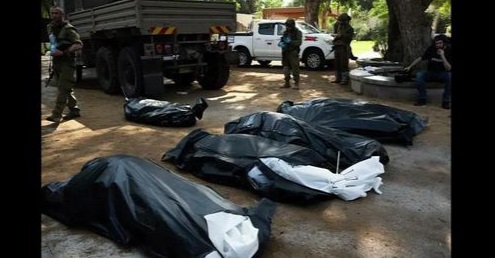
Hamas massacre’s victims. Credit: Gitay Armerman’s FB page.
Background History - Location, Community
Ein HaShlosha, a kibbutz in Israel’s western Negev desert, stands as a symbol of resilience and memory. Named after three founding members who perished in the 1948 Arab–Israeli War, this community was established in the 1950s by Zionist youth from South America, notably members of the HaNoar HaTzioni movement. Located near the Gaza border, Ein HaShlosha has faced significant challenges, including bombardments from the Egyptian army and being a target during various conflicts, notably the Gaza–Israel conflict in 2008. This proximity to conflict zones has exposed the community to frequent danger, including a tragic incident in 2008 when a volunteer from Ecuador that was killed by a Hamas sniper.
The Assault on October 7th
The Ein Hashlosha massacre on October 7, 2023, marked a harrowing escalation in the ongoing Israel-Hamas conflict. Hamas infiltrated the kibbutz, launching a brutal attack against its residents. This assault was part of the broader 2023 Israel–Hamas war, highlighting the ongoing tensions and the vulnerability of communities like Ein HaShlosha located near conflict zones.
Death Toll and Casualties
The Ein Hashlosha massacre led to a significant humanitarian crisis. Israeli forces, after three days of intense search and rescue operations, located 30 missing individuals from the kibbutz. This group, comprising 16 Israelis and 14 Thais, was found alive and well, a testament to the swift response and coordination among various Israeli security forces, including the military, police, and Shin Bet. The incident underscores the human cost of such conflicts and the deep scars they leave on communities.
Evidence from Survivors
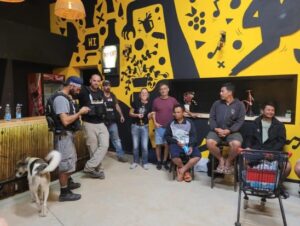
Survivors found in ein Hashlosha on Oct 10th. credit: Lital Peretz’s FB page.
Survivor accounts from the Ein Hashlosha massacre provide a harrowing perspective of the chaos and fear that gripped the community. As Hamas launched its terror attack, residents, in a desperate bid for safety, fled their homes and attempted to find refuge. This situation not only created a sense of panic but also highlighted the psychological trauma that such attacks inflict on civilians. The stories of these survivors serve as a powerful reminder of the human impact of conflict and the importance of striving for peace and security in the region.
The Ein Hashlosha massacre stands as a grim reminder of the volatility of the Israel-Hamas conflict. It underscores the urgent need for a sustainable solution that ensures the safety and security of all people in the region.
-
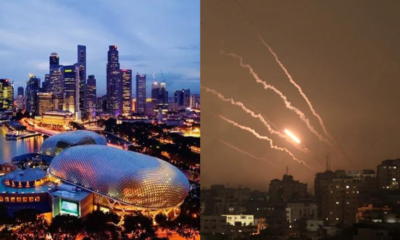
 News3 months ago
News3 months agoGaza could Have Been Singapore. Hamas Turned It Into a living nightmare
-

 News3 months ago
News3 months agoRape, slaughter, and atrocities—see the real face of Hamas
-
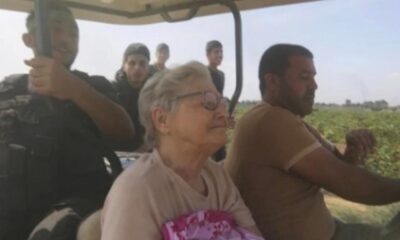
 News3 months ago
News3 months agoKidnapping elderly and children: Hamas are no heroes
-

 News3 months ago
News3 months agoShe died while saving lives.
-

 News3 months ago
News3 months agoTrigger warning: This is the atrocity that’s happening in Israel right now
-
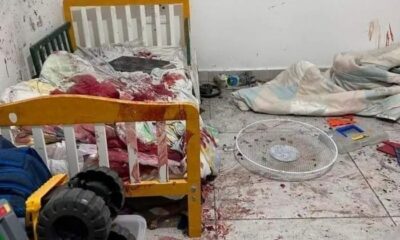
 News3 months ago
News3 months agoMonsters: Yahya Sinwar and Hamas kidnapped 150+ children and women.
-

 Hamas War Strategy, Tactics, and PR3 months ago
Hamas War Strategy, Tactics, and PR3 months agoThe War Crimes of Hamas and ISIS in Exploiting Civilians
-

 News3 months ago
News3 months agoHamas turns a music festival into a massacre






